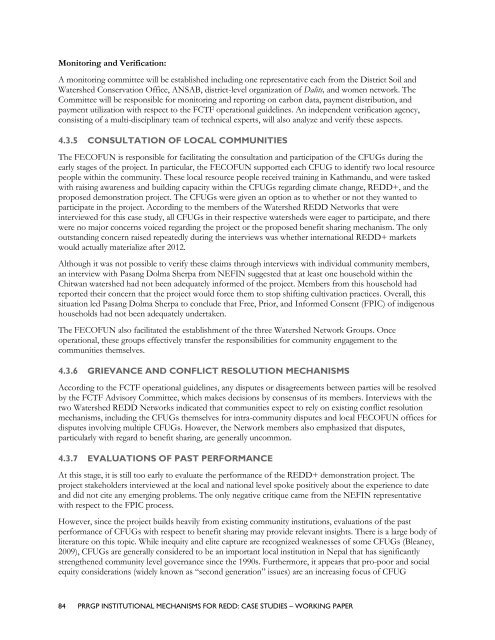Institutional Mechanisms for REDD+ - Case Studies Working Paper
Institutional Mechanisms for REDD+ - Case Studies Working Paper
Institutional Mechanisms for REDD+ - Case Studies Working Paper
Create successful ePaper yourself
Turn your PDF publications into a flip-book with our unique Google optimized e-Paper software.
Monitoring and Verification:<br />
A monitoring committee will be established including one representative each from the District Soil and<br />
Watershed Conservation Office, ANSAB, district-level organization of Dalits, and women network. The<br />
Committee will be responsible <strong>for</strong> monitoring and reporting on carbon data, payment distribution, and<br />
payment utilization with respect to the FCTF operational guidelines. An independent verification agency,<br />
consisting of a multi-disciplinary team of technical experts, will also analyze and verify these aspects.<br />
4.3.5 CONSULTATION OF LOCAL COMMUNITIES<br />
The FECOFUN is responsible <strong>for</strong> facilitating the consultation and participation of the CFUGs during the<br />
early stages of the project. In particular, the FECOFUN supported each CFUG to identify two local resource<br />
people within the community. These local resource people received training in Kathmandu, and were tasked<br />
with raising awareness and building capacity within the CFUGs regarding climate change, <strong>REDD+</strong>, and the<br />
proposed demonstration project. The CFUGs were given an option as to whether or not they wanted to<br />
participate in the project. According to the members of the Watershed REDD Networks that were<br />
interviewed <strong>for</strong> this case study, all CFUGs in their respective watersheds were eager to participate, and there<br />
were no major concerns voiced regarding the project or the proposed benefit sharing mechanism. The only<br />
outstanding concern raised repeatedly during the interviews was whether international <strong>REDD+</strong> markets<br />
would actually materialize after 2012.<br />
Although it was not possible to verify these claims through interviews with individual community members,<br />
an interview with Pasang Dolma Sherpa from NEFIN suggested that at least one household within the<br />
Chitwan watershed had not been adequately in<strong>for</strong>med of the project. Members from this household had<br />
reported their concern that the project would <strong>for</strong>ce them to stop shifting cultivation practices. Overall, this<br />
situation led Pasang Dolma Sherpa to conclude that Free, Prior, and In<strong>for</strong>med Consent (FPIC) of indigenous<br />
households had not been adequately undertaken.<br />
The FECOFUN also facilitated the establishment of the three Watershed Network Groups. Once<br />
operational, these groups effectively transfer the responsibilities <strong>for</strong> community engagement to the<br />
communities themselves.<br />
4.3.6 GRIEVANCE AND CONFLICT RESOLUTION MECHANISMS<br />
According to the FCTF operational guidelines, any disputes or disagreements between parties will be resolved<br />
by the FCTF Advisory Committee, which makes decisions by consensus of its members. Interviews with the<br />
two Watershed REDD Networks indicated that communities expect to rely on existing conflict resolution<br />
mechanisms, including the CFUGs themselves <strong>for</strong> intra-community disputes and local FECOFUN offices <strong>for</strong><br />
disputes involving multiple CFUGs. However, the Network members also emphasized that disputes,<br />
particularly with regard to benefit sharing, are generally uncommon.<br />
4.3.7 EVALUATIONS OF PAST PERFORMANCE<br />
At this stage, it is still too early to evaluate the per<strong>for</strong>mance of the <strong>REDD+</strong> demonstration project. The<br />
project stakeholders interviewed at the local and national level spoke positively about the experience to date<br />
and did not cite any emerging problems. The only negative critique came from the NEFIN representative<br />
with respect to the FPIC process.<br />
However, since the project builds heavily from existing community institutions, evaluations of the past<br />
per<strong>for</strong>mance of CFUGs with respect to benefit sharing may provide relevant insights. There is a large body of<br />
literature on this topic. While inequity and elite capture are recognized weaknesses of some CFUGs (Bleaney,<br />
2009), CFUGs are generally considered to be an important local institution in Nepal that has significantly<br />
strengthened community level governance since the 1990s. Furthermore, it appears that pro-poor and social<br />
equity considerations (widely known as ―second generation‖ issues) are an increasing focus of CFUG<br />
84 PRRGP INSTITUTIONAL MECHANISMS FOR REDD: CASE STUDIES – WORKING PAPER

















